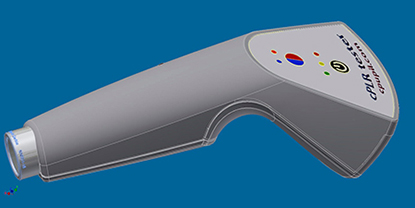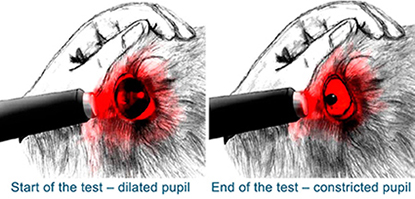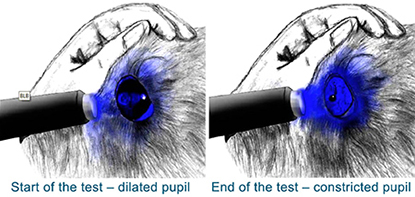 The pupil light reflex evaluation using the cPLR Tester unit:
The pupil light reflex evaluation using the cPLR Tester unit:1. Turn the on button on the back of the instrument.
2. Turn the power button switch (
 ). The instrument will automatically start in the red light mode (the red light diode on the control panel will lit once when instrument is in the red light mode).
Turn off the light in an examination room and dark adapt your patient for 10 seconds.
). The instrument will automatically start in the red light mode (the red light diode on the control panel will lit once when instrument is in the red light mode).
Turn off the light in an examination room and dark adapt your patient for 10 seconds.3. Position the instrument one inch in front of the eye of the patient and activate the instrument by pressing the side button.
 4. Illuminate the left eye with a red light from a distance of one inch for 10 seconds and observe change in the pupil diameter. Remove the light source away from the eye after 10 seconds or when the pupil is maximally constricted (usually it takes 3-4 seconds for the maximal pupil constriction to occur).
4. Illuminate the left eye with a red light from a distance of one inch for 10 seconds and observe change in the pupil diameter. Remove the light source away from the eye after 10 seconds or when the pupil is maximally constricted (usually it takes 3-4 seconds for the maximal pupil constriction to occur).5. Wait for 30 seconds so dark adaptation is achieved and pupil is fully dilated, then illuminate the right eye with a red light for 10 seconds and observe the change in the pupil diameter.
6. Press the red-blue button to switch the instrument in the blue light mode (blue diode on the control panel will lit once when instrument is in the blue light mode) and wait for 30 seconds for the pupil dilatation.
 7. Illuminate the left eye with a blue light from a distance of one inch for 10 seconds and observe change in the pupil diameter. Remove the light source away from the eye after 10 seconds or when the pupil is maximally constricted (usually it takes 3-4 seconds for the maximal pupil constriction to occur). Illumination with blue light usually results in somewhat faster and more complete constriction in healthy eyes.
7. Illuminate the left eye with a blue light from a distance of one inch for 10 seconds and observe change in the pupil diameter. Remove the light source away from the eye after 10 seconds or when the pupil is maximally constricted (usually it takes 3-4 seconds for the maximal pupil constriction to occur). Illumination with blue light usually results in somewhat faster and more complete constriction in healthy eyes.8. Wait for 30 seconds so dark adaptation is achieved and pupil is fully dilated, then illuminate the right eye with a blue light for 10 seconds and observe the change in the pupil diameter.
9. After all responses are observed and recorded, use obtained results in combination with other parameters obtained during clinical examination to establish final diagnosis. Evaluation of pupil light reflex responses only in absence of other diagnostic results obtained during eye examination, can not be used to establish the final diagnosis, but rather to establish a possible anatomic localization of the visual system abnormality (retina, optic nerve or brain problem).
